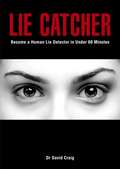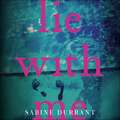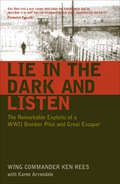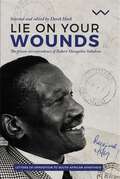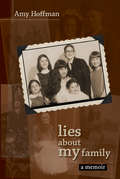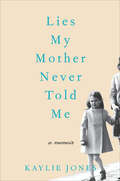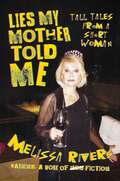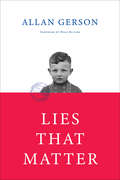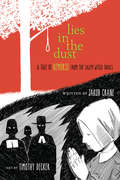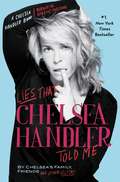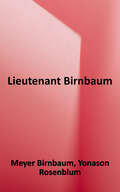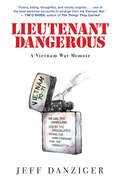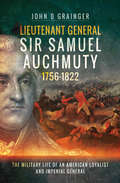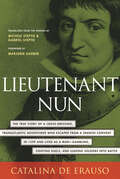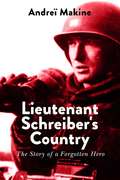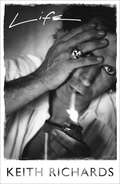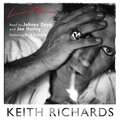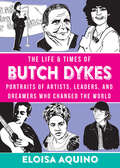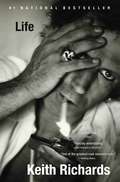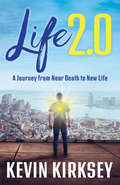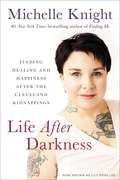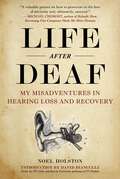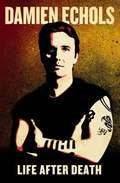- Table View
- List View
Lie Catcher: Become a Human Lie Detector in Under 60 Minutes
by Dr. David CraigInternational undercover expert and criminologist Dr David Craig gives us an easy-to-read, light-hearted guide that demonstrates through practical examples how to apply lie detecting skills in our day-to-day lives. From bargaining, making a purchase, negotiating a business contract, dealing with children to identifying infidelity, he delivers simple but effective tips and techniques we can all use to see behind the facade and get to the truth.
Lie With Me: The must-read Richard & Judy Bookclub Pick
by Sabine DurrantThe truth is, we all tell lies... take a deep breath and get ready for the most twisty, tense and unsettling book of the summer. 'If, like me, you have been longing for a psycho-thriller of genius since you finished Gone Girl, then the wait is finally over. There are very few books in this world that are impossible to put down. Lie With Me is one of them.' Tony ParsonsIt starts with a lie. The kind we've all told - to a former acquaintance we can't quite place but still, for some reason, feel the need to impress. The story of our life, embellished for the benefit of the happily married lawyer with the kids and the lovely home.And the next thing you know, you're having dinner at their house, and accepting an invitation to join them on holiday - swept up in their perfect life, the kind you always dreamed of...Which turns out to be less than perfect. But by the time you're trapped and sweating in the relentless Greek sun, burning to escape the tension all around you - by the time you start to realise that, however painful the truth might be, it's the lies that cause the real damage...... well, by then, it could just be too late.(P) 2016 Hodder & Stoughton
Lie in the Dark and Listen: The Remarkable Expliots of a WWII Bomber Pilot and Great Escaper
by Ken Rees Karen ArrandaleA memoir of a World War II British bomber pilot who was imprisoned by the Nazis and went on to inspire the Steve McQueen character in The Great Escape. By age 21, Ken had already trained to be a pilot officer, flown 56 hair-raising bomber missions by night over Germany, taken part in the siege of Malta, got married, been shot down into a remote Norwegian lake, been captured and interrogated, sent to Stalag Luft III, and survived the Great Escape and the forced March to Bremen. This is truly a real-life adventure story, written with accuracy, pace, and drama. &“Ken Rees had a war career that takes the breath away and he describes it so well one can imagine one was there, experiencing the terror.&” —Frederick Forsyth, #1 New York Times – bestselling author of The Fox and The Day of the Jackal &“In an age obsessed with C-list television celebrities battling it out on [phony] &“reality&” survival shows, Rees and his dwindling band of Great Escapers stand out as the real thing.&” —The Daily Telegraph (UK) &“Written in frank, warm and readable style, this is a very engaging account of a remarkable life.&” —New History &“A brave man&’s memory. Hear the fear yet take [succor] from the courage.&” —North Wales Chronicle (UK)
Lie on your wounds: The prison correspondence of Robert Mangaliso Sobukwe
by Robert SobukweSelection of Robert Mangaliso Sobukwe’s letters from prison in opposition to South African apartheidThis book collates nearly 300 prison letters to and from Robert Mangaliso Sobukwe, inspirational political leader and first President of the Pan-Africanist Congress. These letters are testimony to the desolate conditions of his imprisonment and to his unbending commitment to the cause of African liberation.The memory of Sobukwe has been sadly neglected in post- apartheid South Africa. With the changing political climate, the decline of the African National Congress’s power, the re- emergence of Black Consciousness, and the growth of student protests, Sobukwe is being looked to once again.
Lies About My Family: A Memoir
by Amy HoffmanThis well-crafted family memoir is about the stories that are told and the ones that are not told, and about the ways the meanings of the stories change down the generations. It is about memory and the spaces between memories, and about alienation and reconciliation. All of Amy Hoffman's grandparents came to the United States during the early twentieth century from areas in Poland and Russia that are now Belarus and Ukraine. Like millions of immigrants, they left their homes because of hopeless poverty, looking for better lives or at the least a chance of survival. Because of the luck, hard work, and resourcefulness of the earlier generations, Hoffman and her five siblings grew up in a middle-class home, healthy, well fed, and well educated. An American success story? Not quite--or at least not quite the standard version. Hoffman's research in the Ellis Island archives along with interviews with family members reveal that the real lives of these relatives were far more complicated and interesting than their documents might suggest. Hoffman and her siblings grew up as observant Jews in a heavily Catholic New Jersey suburb, as political progressives in a town full of Republicans, as readers in a school full of football players and their fans. As a young lesbian, she distanced herself from her parents, who didn't understand her choice, and from the Jewish community, with its organization around family and unquestioning Zionism. However, both she and her parents changed and evolved, and by the end of this engaging narrative, they have come to new understandings, of themselves and one another.
Lies My Mother Never Told Me: A Memoir
by Kaylie JonesHer mother was a brainy knockout with the sultry beauty of Marilyn Monroe, a raconteur whose fierce wit could shock an audience into hilarity or silence. Her father was a distinguished figure in American letters, the National Book Award–winning author of four of the greatest novels of World War II ever written. A daughter of privilege with a seemingly fairy-tale-like life, Kaylie Jones was raised in the Hamptons via France in the 1960s and '70s, surrounded by the glitterati who orbited her famous father, James Jones. Legendary for their hospitality, her handsome, celebrated parents held court in their home around an antique bar—an eighteenth-century wooden pulpit taken from a French village church—playing host to writers, actors, movie stars, film directors, socialites, diplomats, an emperor, and even the occasional spy. Kaylie grew up amid such family friends as William Styron, Irwin Shaw, James Baldwin, and Willie Morris, and socialized with the likes of Truman Capote, Norman Mailer, George Plimpton, and Kurt Vonnegut.Her beloved father showed young Kaylie the value of humility, hard work, and education, with its power to overcome ignorance, intolerance, and narrow-mindedness, and instilled in her a love of books and knowledge. From her mother, Gloria, she learned perfect posture, the twist, the fear of abandonment, and soul-shattering cruelty. Two constants defined Kaylie's childhood: literature and alcohol. "Only one word was whispered in the house, as if it were the worst insult you could call someone," she writes, "alcoholic was a word my parents reserved for the most appalling and shameful cases—drunks who made public scenes or tried to kill themselves or ended up in the street or in an institution. If you could hold your liquor and go to work, you were definitely not an alcoholic." When her father died from heart failure complicated by years of drinking, sixteen-year-old Kaylie was broken and lost. For solace she turned to his work, looking beyond the man she worshipped to discover the artist and his craft, determined that she too would write. Her loss also left her powerless to withstand her mother's withering barbs and shattering criticism, or halt Gloria's further descent into a bottle—one of the few things mother and daughter shared. From adolescence, Kaylie too used drink as a refuge, a way to anesthetize her sadness, anger, and terror. For years after her father's death, she denied the blackouts, the hangovers, the lost days, the rage, the depression. Broken and bereft, she began reading her father's novels and those writers who came before and after him—and also pursued her own writing. With this, she found the courage to open the door on the truth of her own addiction.Lies My Mother Never Told Me is the mesmerizing and luminously told story of Kaylie's battle with alcoholism and her struggle to flourish despite the looming shadow of a famous father and an emotionally abusive and damaged mother. Deeply intimate, brutally honest, yet limned by humor and grace, it is a beautifully written tale of personal evolution, family secrets, second chances, and one determined woman's journey to find her own voice—and the courage to embrace a life filled with possibility, strength, and love.
Lies My Mother Told Me: Tall Tales from a Short Woman
by Melissa RiversIf you think Joan Rivers said funny, outrageous, and ridiculous things ONSTAGE, wait &’til you read the funny, outrageous, and ridiculous things she said OFFSTAGE…things that will make you laugh out loud…and keep Melissa in therapy for the foreseeable future.The only thing my mother loved more than making people laugh was lying…or as she&’d say, &“embellishing.&” Her motto was: &“Why let the truth ruin a good story?&” This book contains some of those stories. ***************** &“When Joan told a story, the truth disappeared faster than I did.&” — Jimmy Hoffa &“If you thought Dante&’s Inferno was hot, read Lies My Mother Told Me; it&’s a five-alarmer.&” — Dante&’s second wife, Allie &“Twelve of my twenty-six personalities loved this book.&” — Sybil &“The words on the page absolutely crackle and spark; I burned my fingers reading it!&” — Annie Sullivan &“The Bible may be the good book, but Lies My Mother Told Me is way funnier.&” — Matthew 2:14 The Jets. 7 &“Lies My Mother Told Me is the feel-good book of 2022.&” — Torquemada &“All&’s not well that ends well. I&’ve had massages with happier endings.&” — Wm. Shakespeare &“Melissa, I don&’t care what your mother said in this book, I LOVE your bangs.&” — Mamie Eisenhower &“Lies My Mother Told Me is so funny even those &‘woke&’ m***********s will laugh.&” — Lenny Bruce
Lies That Matter: A federal prosecutor and child of Holocaust survivors, tasked with stripping US citizenship from aged Nazi collaborators, finds himself caught in the middle
by Allan GersonThe true story of a DOJ prosecutor’s complicated quest to deport Nazis: “The lessons that Mr. Gerson learns, and shares, could not be more timely.” —Seth Waxman, former US Solicitor GeneralAs the son of Holocaust survivors, federal prosecutor Allan Gerson thought his professional assignment to investigate and deport those who persecuted his family and others like them would make his parents proud. But their reaction was not what he expected. This is his memoir of the experience—and the complex emotions and questions it provoked.“It takes a young attorney whose Holocaust survivor parents and uncle had to lie in order to gain admittance into the U.S. to recognize the double-edged dangers of pursuing aging Nazi functionaries with the blunt instruments of American immigration law. Can the same laws be turned against his parents and other Jews like them? Allan Gerson tells the gripping story of his two years at the Department of Justice office charged with investigating and deporting aging Nazis living quietly in our midst. His interrogation of suspected perpetrators forces him to uncover secrets of his family and other anguished victims that he never wanted to know . . . This narrative reads like a bildungsroman, a coming of age story of a lawyer who went on to seek American legal remedies for historic crimes and injustices committed elsewhere.” —Samuel Norich, President, The Forward
Lies in the Dust: A Tale of Remorse from the Salem Witch Trials
by Jakob CraneIn Salem’s dark days of 1692 and 1693, young girls pointed fingers and accused others of witchcraft, sentencing them to torture or even death. When the cloud lifted, and accusations were shown to be false, the girls faced little, if any, penalty. Were they sorry? No one knows. Only one girl, Ann Putnam, Jr., felt moved to show remorse publicly. Fourteen years after the trials, Ann wrote a letter of apology. This is her story.
Lies that Chelsea Handler Told Me (A Chelsea Handler Book/Borderline Amazing Publishing)
by Chelsea Handler"My tendency to make up stories and lie compulsively for the sake of my own amusement takes up a good portion of my day and provides me with a peace of mind not easily attainable in this economic climate."--Chelsea Handler, from Chapter 10 of Chelsea Chelsea Bang Bang It's no lie: Chelsea Handler loves to smoke out "dumbassness," the condition people suffer from that allows them to fall prey to her brand of complete and utter nonsense. Friends, family, co-workers--they've all been tricked by Chelsea into believing stories of total foolishness and into behaving like total fools. Luckily, they've lived to tell the tales and, for the very first time, write about them.
Lieutenant Birnbaum: A Soldier's Story
by Meyer BirnbaumJoin Meyer Birnbaum as he enlists in the U.S. Army, helps liberate Buchenwald, trains youngsters for Israel's War of Independence, and drives the Mirrer Rosh Yeshivah and countless others daily to the sunrise minyan at the Kosel.
Lieutenant Dangerous: A Vietnam War Memoir
by Jeff Danziger"A must-read war memoir… with zero punches pulled, related by one of the most incisive observers of the American political scene." —KIRKUS (starred review) "Funny, biting, thoughtful and wholly original." —Tim O'Brien, author of The Things They CarriedJeff Danziger, one of the leading political cartoonists of his generation, captures the fear, sorrow, absurdity, and unintended but inevitable consequences of war with dark humor and penetrating moral clarity.If there is any discipline at the start of wars it dissipates as the soldiers themselves become aware of the pointlessness of what they are being told to do. A conversation with a group of today&’s military age men and women about America&’s involvement in Vietnam inspired Jeff Danziger to write about his own wartime experiences: &“War is interesting,&” he reveals, &“if you can avoid getting killed, and don&’t mind loud noises.&” Fans of his cartooning will recognize his mordant humor applied to his own wartime training and combat experiences: &“I learned, and I think most veterans learn, that making people or nations do something by bombing or sending in armed troops usually fails.&” Near the end of his telling, Danziger invites his audience—in particular the young friends who inspired him to write this informative and rollicking memoir—to ponder: &“What would you do? . . . Could you summon the bravery—or the internal resistance—to simply refuse to be part of the whole idiotic theater of the war? . . . Or would you be like me?&”
Lieutenant General Sir Samuel Auchmuty, 1756–1822: The Military Life of an American Loyalist and Imperial General
by John D. GraingerSamuel Auchmuty was born in New York in 1756. During the American Revolution his remained loyal to King George and he joined the British 45th Foot in 1777. After the war he remained in British service, campaigned in many parts of the world and rose through the ranks. Despite a varied and distinguished career he has not received the attention he warrants, neither as a Loyalist from New York, nor as a successful British soldier.Auchmuty served in India through the Second and Third Mysore Wars, the Rohilla War and a serious mutiny. In 1798 Auchmuty was adjutant-general of the successful Red Sea campaign against French forces in Egypt. Returning to Britain in 1803 he commanded the defences in Thanet, East Kent, at the height of the French invasion threat. He was the only British commander to emerge from the River Plate campaign with credit, capturing Montevideo in 1807. In 1811 he commanded the land forces that captured Java from Franco-Dutch control. He ended his life as Commander-in-Chief, Ireland. John Grainger examines his part in events which shaped world history.
Lieutenant Nun: Memoir of a Basque Transvestite in the New World
by Catalina De ErausoOne of the earliest known autobiographies by a woman, this is the extraordinary tale of Catalina de Erauso, who in 1599 escaped from a Basque convent dressed as a man and went on to live one of the most wildly fantastic lives of any woman in history. A soldier in the Spanish army, she traveled to Peru and Chile, became a gambler, and even mistakenly killed her own brother in a duel. During her lifetime she emerged as the adored folkloric hero of the Spanish-speaking world. This delightful translation of Catalina's own work introduces a new audience to her audacious escapades.
Lieutenant Schreiber's Country: The Story of a Forgotten Hero
by Andrei MakineJean-Claude Servan-Schreiber enlisted in the French army at the outset of World War II and quickly rose to the rank of lieutenant. Despite his patriotism and courage in defending his country, in which he narrowly escaped death several times, he suffered the bigotry of his fellow soldiers until he was expelled from the army for being Jewish. He sought exile in Spain and was deported and interned in a concentration camp before he managed to join the Allied army in North Africa. He eventually participated in the triumphant liberation of his homeland.His story, almost forgotten, would have remained unknown if not for the efforts of the award-winning and internationally bestselling author Andrei Makine, Retelling Servan-Schreiber's dramatic life with a novelist's skill, he reveals a man who embraced experience in all its joys and sorrows, who knew the pleasures of love amid the savagery of war, and who could forgive the hatred he was subjected to but never forget it. In Servan-Schreiber, who is now nearly a centenarian, Makine celebrates virtues that every citizen should be reminded of: self-sacrifice, honor, love of country, and true heroism.
Life
by Keith RichardsOnce-in-a-generation memoir of a rock legend - the No. 1 SUNDAY TIMES bestseller.'Electrifying' New York Times'A masterpiece' The Word'Funny, poignant, brutally honest' Sunday TelegraphWith the Rolling Stones, Keith Richards created the riffs, the lyrics and the songs that roused the world, and over four decades he lived the original rock and roll life: taking the chances he wanted, speaking his mind, and making it all work in a way that no one before him had ever done.Now, at last, the man himself tells us the story of life in the crossfire hurricane. And what a life. Listening obsessively to Chuck Berry and Muddy Waters records as a child in post-war Kent. Learning guitar and forming a band with Mick Jagger and Brian Jones. The Rolling Stones' first fame and success as a bad-boy band. The notorious Redlands drug bust and subsequent series of confrontations with a nervous establishment that led to his enduring image as outlaw and folk hero. Creating immortal riffs such as the ones in 'Jumping Jack Flash' and 'Street Fighting Man' and 'Honky Tonk Women'. Falling in love with Anita Pallenberg and the death of Brian Jones. Tax exile in France, wildfire tours of the US, 'Exile on Main Street' and 'Some Girls'. Ever increasing fame, isolation and addiction. Falling in love with Patti Hansen. Estrangement from Mick Jagger and subsequent reconciliation. Solo albums and performances with his band the Xpensive Winos. Marriage, family and the road that goes on for ever. In a voice that is uniquely and intimately his own, with the disarming honesty that has always been his trademark, Keith Richards brings us the essential life story of our times.
Life
by Keith RichardsOnce-in-a-generation memoir of a rock legend - the No. 1 SUNDAY TIMES bestseller.'Electrifying' New York Times'A masterpiece' The Word'Funny, poignant, brutally honest' Sunday TelegraphWith the Rolling Stones, Keith Richards created the riffs, the lyrics and the songs that roused the world, and over four decades he lived the original rock and roll life: taking the chances he wanted, speaking his mind, and making it all work in a way that no one before him had ever done.Now, at last, the man himself tells us the story of life in the crossfire hurricane. And what a life. Listening obsessively to Chuck Berry and Muddy Waters records as a child in post-war Kent. Learning guitar and forming a band with Mick Jagger and Brian Jones. The Rolling Stones' first fame and success as a bad-boy band. The notorious Redlands drug bust and subsequent series of confrontations with a nervous establishment that led to his enduring image as outlaw and folk hero. Creating immortal riffs such as the ones in 'Jumping Jack Flash' and 'Street Fighting Man' and 'Honky Tonk Women'. Falling in love with Anita Pallenberg and the death of Brian Jones. Tax exile in France, wildfire tours of the US, 'Exile on Main Street' and 'Some Girls'. Ever increasing fame, isolation and addiction. Falling in love with Patti Hansen. Estrangement from Mick Jagger and subsequent reconciliation. Solo albums and performances with his band the Xpensive Winos. Marriage, family and the road that goes on for ever. In a voice that is uniquely and intimately his own, with the disarming honesty that has always been his trademark, Keith Richards brings us the essential life story of our times.
Life & Times of Butch Dykes, The: Portraits of Artists, Leaders, and Dreamers Who Changed The World
by Eloisa AquinoPortraits of women throughout history who have defied society's expectations of feminine behavior and appearance in order to live a more authentic life. These short vignettes combine biographical sketches with evocative illustrations for an impact that is as bold, powerful, and inspirational as the brilliant artists, writers, and musicians they represent. The notable people profiled in this book include Audre Lorde (activist and poet), JD Sampson (artist, and musician known for Le Tigre and MAN), Jenny Shimizu (model and actress), Claude Cahun (photographer, performer, and writer who defied all gender expectations and wasn't any gender), Esther Eng (director), Gladys Bentley (singer and performer), Gertrude Stein (author and poet), Martina Navratilova (tennis champion), and Gloria Anzaldúa (scholar). Author and artist Eloisa Aquino presents these icons against heteronormativity in a good-humored homage, showing how the courage to be true to yourself can spark the sort of work that changes the world.
Life (Orion 20th Anniversary Editions Ser.)
by James Fox Keith RichardsAs lead guitarist of the Rolling Stones, Keith Richards created the riffs, the lyrics, and the songs that roused the world. A true and towering original, he has always walked his own path, spoken his mind, and done things his own way.Now at last Richards pauses to tell his story in the most anticipated autobiography in decades. And what a story! Listening obsessively to Chuck Berry and Muddy Waters records in a coldwater flat with Mick Jagger and Brian Jones, building a sound and a band out of music they loved. Finding fame and success as a bad-boy band, only to find themselves challenged by authorities everywhere. Dropping his guitar's sixth string to create a new sound that allowed him to create immortal riffs like those in "Honky Tonk Woman" and "Jumpin' Jack Flash." Falling in love with Anita Pallenberg, Brian Jones's girlfriend. Arrested and imprisoned for drug possession. Tax exile in France and recording Exile on Main Street. Ever-increasing fame, isolation, and addiction making life an ever faster frenzy. Through it all, Richards remained devoted to the music of the band, until even that was challenged by Mick Jagger's attempt at a solo career, leading to a decade of conflicts and ultimately the biggest reunion tour in history.In a voice that is uniquely and unmistakably him--part growl, part laugh--Keith Richards brings us the truest rock-and-roll life of our times, unfettered and fearless and true. Richards' rich voice introduces the audiobook edition of LIFE and leads us into Johnny Depp's performance, while fellow artist Joe Hurley bridges the long road traveled before Richards closes with the final chapter of this incredible 23-hour production, which includes a bonus PDF of photos.
Life 2.0: A Journey from Near Death to New Life
by Kevin KirkseyAn inspirational memoir of one man’s transformation after being near-death and witnessing the selfless acts of others.One day, while leaving a routine doctor’s appointment, Kevin asks his doctor a simple question that later proves to save, extend, and profoundly change his life—a question he believes is divinely inspired. Life 2.0 follows Kevin’s journey through open-heart surgery and recovery. But, more than that, this is the story of the impact little things can have when people open their hearts.As Kevin journeys through recovery and rehabilitation, he starts to notice the selfless little things others do—and develops a new perspective on life. Coupled with encounters with Angels, Kevin’s new life is molded into a life of profound physical, emotional, and spiritual change, and he decided to call it Life 2.0. An inspiration for healthcare providers, patients, and their families, Life 2.0 demonstrates how the little things can profoundly impact the lives of others and how anyone, if they so choose, can live their own Life 2.0.“Kevin has not only redefined the world around him, but his ability to inspire and motivate others in the path of happiness and faith-filled living is remarkable! His love for family and care for all those who meet him have inspired me to be a better version of myself . . . imagine the world if we all rejoiced as Kevin does in Life 2.0.” —Susan K. Moats, DNP, MBA, RN, NEA, BC, Chief Nursing Officer, Vice President of Patient Care Services
Life After Darkness: Finding Healing and Happiness After the Cleveland Kidnappings
by Michelle KnightFrom Michelle Knight-Cleveland kidnapping survivor and #1 NYT bestselling author of Finding Me-comes an inspirational book about healing and resilience, on the five-year anniversary of her escape.Michelle Knight-now known as Lily Rose Lee-captured the world's attention in May 2013, when she and two fellow kidnapping victims were found and freed after being held for more than a decade by notorious Cleveland kidnapper Ariel Castro. But many people are still asking: What happened after her escape? How do you re-enter society after years of abuse and isolation? How do you get past the trauma and live a happy and joy filled life? How do you learn to trust again? In Life After Darkness, published on the fifth anniversary of her liberation, Lily describes how she managed to heal the wounds to her body, mind, and soul-wounds, she reveals, that were first inflicted even before her kidnapping. With the help of good friends and anchored by her own inner strength, she takes us with her step by step on her journey out of darkness into the light. An inspiring story-and for anyone who has dared to hope after suffering, a guidebook to finding new purpose for a meaningful life.
Life After Deaf: My Misadventures in Hearing Loss and Recovery
by Noel HolstonFrom a renowned media critic to a man with sudden and full hearing loss, Noel Holston ran the gauntlet of diagnoses, health insurance, and cochlear implant surgery. On a spring night in 2010, Noel Holston, a journalist, songwriter, and storyteller, went to bed with reasonably intact hearing. By dawn, it was gone, thus beginning a long process of hearing-restoration that included misdiagnoses, an obstinate health-insurance bureaucracy, failed cochlear-implant surgery, and a second surgery that finally worked. He negotiated the gauntlet with a wry sense of humor and the aid of his supportive wife, Marty. Life After Deaf details his experience with warmth, understanding, and candor. It&’s the story not only of his way back to the world of the hearing, but of a great marriage that weathered serious testing. Their determination and resilience serve as a source of inspiration for all.Life After Deaf is not just for the more than forty million people in the United States alone who cope with some form of hearing loss, but is also for their wide circles of friends, family, caregivers, and audiologists. This highly readable book will be an invaluable guide and source of hope for the large number of baby boomers now handling hearing loss.
Life After Death
by Damien EcholsThe true story of the wrongful conviction of the infamous West Memphis Three, Life After Death is a powerful and unflinching first-person account of life on death row. In 1993 three teenagers, Damien Echols, Jason Baldwin and Jessie Miskelley Jr, were arrested and charged with the murders of three eight-year-old boys in West Memphis, Arkansas. The ensuing trial was rife with inconsistencies, false testimony and superstition. Echols was accused of, among other things, practising witchcraft and satanic rituals -- a result of the 'satanic panic' prevalent in the media at the time. Baldwin and Miskelley were sentenced to life in prison. Echols, deemed the ringleader, was sentenced to death. He was eighteen years old. In a shocking reversal of events, all three were suddenly released in August 2011. This is Damien Echols' story in full: from abuses by prison guards and wardens, to descriptions of inmates and deplorable living conditions, to the incredible reserves of patience, spirituality, and perseverance that kept him alive and sane for nearly two decades. Echols also writes about his complicated and painful childhood. Like Dead Man Walking, Life After Death is destined to be a classic West of Memphis, a documentary produced by Peter Jackson (director of the Lord of the Rings trilogy) and Fran Walsh, details the campaign to have their sentences overturned The West Memphis Three are also the subject of Paradise Lost, a three-part documentary series produced by HBO.
Life After Death: Surviving Suicide
by Richard BrockmanAn intertwined tale of a boy&’s world shattered by suicide and a man&’s story rewritten by neuroscience. When Richard Brockman found his mother&’s body, the simple narrative of his childhood ended. Life After Death tells the story of a boy who died and of a man who survived when the boy and the man are one and the same. It tells a very personal—yet tragically common—story of irredeemable loss. It tells the story of story itself. How story forms. How it grows. How it changes. How it can be broken. And finally, how sometimes it can be repaired. Now an expert in genetics, epigenetics, and the biology of attachment, Brockman chronicles his evolution from a child overwhelmed by trauma to a man who has struggled to reclaim his past. He lays bare the core of one who is both victim and healer. By weaving together childhood despair and clinical knowledge, Brockman shows how the shattered pieces of the self—though never the same and not without scars—can sometimes be put back together again.
